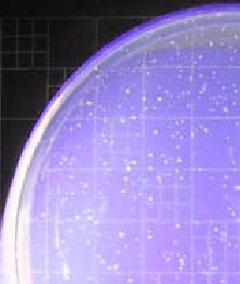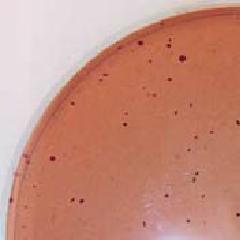- Yokohama-shi Top Page
- Health, Medical Care and Welfare
- Health and Medical Care
- Food safety
- Food Sanitation Laboratory
- Bacterial testing
- Pollution indicator bacteria test
Here's the text.
Pollution indicator bacteria test
Last update date April 2, 2024
What is pollution indicator bacteria?
Inspections are conducted to understand the contamination status of microorganisms such as food, cooking utensils, and fingers, and to objectively evaluate the suitability of hygiene management.
Pollution index bacteria include "general bacteria count", "E. coliforms", and "E. coli".
By examining these bacteria, you can estimate the degree of contamination and the presence or absence of pathogenic bacteria.
General bacterial number

Colony in standard agar medium
This refers to the number of bacteria found in aerobic (needs oxygen) condition and cultured at 35 ° C.
This amount of general bacteria reflects the state of bacterial contamination in food and the environment in which they were produced, and most of the causative bacteria that occur through food grow well at around 35 ° C. It is an extremely powerful indicator for comprehensive evaluation of food safety, preservation, and hygienic handling of food.
General bacteria do not directly refer to safety, but a large number of general bacteria indicates the presence of pathogenic bacteria and the possibility that those bacteria may be growing.
Inspection methods
Using standard agar medium, all grown colonies are counted, and the number of common bacteria per g of food is calculated.
Coliforms

Escherichia coliforms in desoxycolate agar medium
Drinking water, etc., it is regarded as an indicator of feces pollution, but in foods it is mainly used as an indicator of heating.
- Food for which coliform component standards are set
- Milk, dairy products, soft drinks, ice and snow
- Heated meat products (heated after packaging) and fish paste products
- Non-heated frozen foods
- Intake after heating immediately before freezing Frozen foods
- Ice confectionery
- Frozen boiled octopus, whale meat products
Inspection methods
- Methods of using desoxycolate agar medium (such as ice confectionery)
If a dark red colony is recognized after culture, the estimated test is positive, and a final test will be conducted on the EMB medium and a complete test with lactose bouillon and gram staining.
- Methods using BGLB medium and LB medium (soft drink, fish meat kneaded products, etc.)
If the sample solution is added to the medium containing the fermentation tube and culture is generated, a definitive test and a complete test are performed.
Escherichia coli (E.coli)
These mean that there was relatively new feces pollution directly or indirectly because they are more likely to exist in human and animal feces than coliforms and are more likely to die in nature. If detected, it can be said that there is a high possibility of contamination of intestinal pathogenic bacteria.
It is applied to unheated foods such as raw vegetables, raw meat, and seafood that reflects pollution from the natural world.
- Food for which coli ingredient standard is set
- Some meat products, oysters for raw food
- Unheated immediately before freezing Frozen foods
However, Escherichia coli specified in these standards is precisely fecal coliforms.
Inspection methods
Judgment is made based on gas production using EC culture medium. In the case of gas production, definitive tests and complete tests may be conducted.
Other pollution indicator bacteria
Other pollution index bacteria include "intestinal bacteria, low-temperature bacteria, high-temperature bacteria, and spore bacteria."
For inquiries to this page
Medical Care Bureau Health and Safety Department Central Wholesale Market Home Food Sanitation Laboratory
Phone: 045-441-1153
Phone: 045-441-1153
Fax: 045-441-8009
Email address: ir-honjo@city.yokohama.jp
Page ID: 388-580-172







